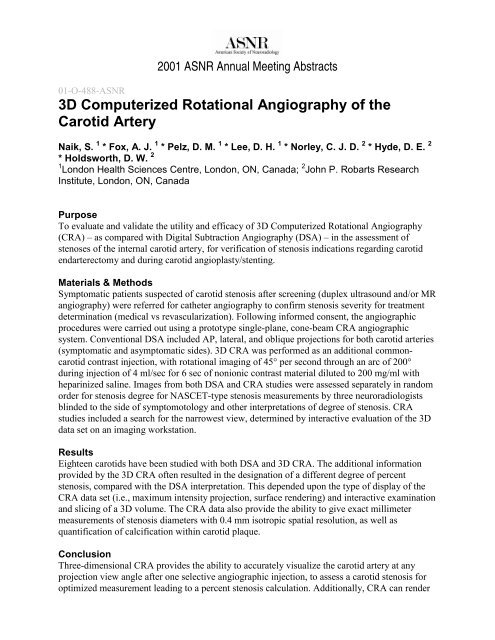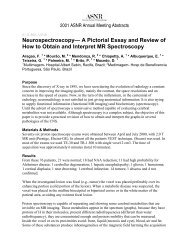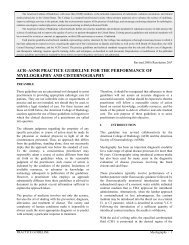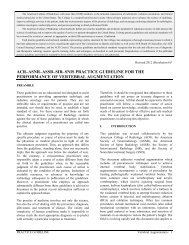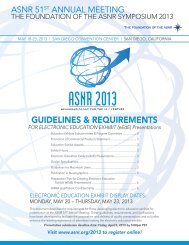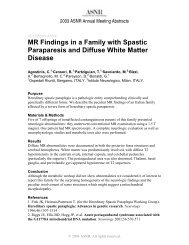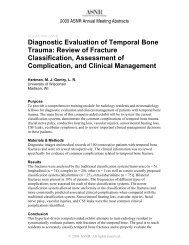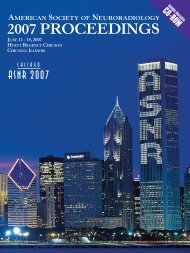3D Computerized Rotational Angiography of the ... - For Members
3D Computerized Rotational Angiography of the ... - For Members
3D Computerized Rotational Angiography of the ... - For Members
Create successful ePaper yourself
Turn your PDF publications into a flip-book with our unique Google optimized e-Paper software.
2001 ASNR Annual Meeting Abstracts01-O-488-ASNR<strong>3D</strong> <strong>Computerized</strong> <strong>Rotational</strong> <strong>Angiography</strong> <strong>of</strong> <strong>the</strong>Carotid ArteryNaik, S. 1 * Fox, A. J. 1 * Pelz, D. M. 1 * Lee, D. H. 1 * Norley, C. J. D. 2 * Hyde, D. E. 2* Holdsworth, D. W. 21 London Health Sciences Centre, London, ON, Canada; 2 John P. Robarts ResearchInstitute, London, ON, CanadaPurposeTo evaluate and validate <strong>the</strong> utility and efficacy <strong>of</strong> <strong>3D</strong> <strong>Computerized</strong> <strong>Rotational</strong> <strong>Angiography</strong>(CRA) – as compared with Digital Subtraction <strong>Angiography</strong> (DSA) – in <strong>the</strong> assessment <strong>of</strong>stenoses <strong>of</strong> <strong>the</strong> internal carotid artery, for verification <strong>of</strong> stenosis indications regarding carotidendarterectomy and during carotid angioplasty/stenting.Materials & MethodsSymptomatic patients suspected <strong>of</strong> carotid stenosis after screening (duplex ultrasound and/or MRangiography) were referred for ca<strong>the</strong>ter angiography to confirm stenosis severity for treatmentdetermination (medical vs revascularization). Following informed consent, <strong>the</strong> angiographicprocedures were carried out using a prototype single-plane, cone-beam CRA angiographicsystem. Conventional DSA included AP, lateral, and oblique projections for both carotid arteries(symptomatic and asymptomatic sides). <strong>3D</strong> CRA was performed as an additional commoncarotidcontrast injection, with rotational imaging <strong>of</strong> 45° per second through an arc <strong>of</strong> 200°during injection <strong>of</strong> 4 ml/sec for 6 sec <strong>of</strong> nonionic contrast material diluted to 200 mg/ml withheparinized saline. Images from both DSA and CRA studies were assessed separately in randomorder for stenosis degree for NASCET-type stenosis measurements by three neuroradiologistsblinded to <strong>the</strong> side <strong>of</strong> symptomotology and o<strong>the</strong>r interpretations <strong>of</strong> degree <strong>of</strong> stenosis. CRAstudies included a search for <strong>the</strong> narrowest view, determined by interactive evaluation <strong>of</strong> <strong>the</strong> <strong>3D</strong>data set on an imaging workstation.ResultsEighteen carotids have been studied with both DSA and <strong>3D</strong> CRA. The additional informationprovided by <strong>the</strong> <strong>3D</strong> CRA <strong>of</strong>ten resulted in <strong>the</strong> designation <strong>of</strong> a different degree <strong>of</strong> percentstenosis, compared with <strong>the</strong> DSA interpretation. This depended upon <strong>the</strong> type <strong>of</strong> display <strong>of</strong> <strong>the</strong>CRA data set (i.e., maximum intensity projection, surface rendering) and interactive examinationand slicing <strong>of</strong> a <strong>3D</strong> volume. The CRA data also provide <strong>the</strong> ability to give exact millimetermeasurements <strong>of</strong> stenosis diameters with 0.4 mm isotropic spatial resolution, as well asquantification <strong>of</strong> calcification within carotid plaque.ConclusionThree-dimensional CRA provides <strong>the</strong> ability to accurately visualize <strong>the</strong> carotid artery at anyprojection view angle after one selective angiographic injection, to assess a carotid stenosis foroptimized measurement leading to a percent stenosis calculation. Additionally, CRA can render
as unnecessary percent stenosis calculations, as it can provide true millimeter stenosismeasurements.References1. Fahrig R, Fox AJ, Lownie S, Holdsworth DW. Use <strong>of</strong> a C-arm system to generate truethree-dimensional computed rotational angiograms: preliminary in vitro and in vivoresults. AJNR Am J Neuroradiol 1997;18;1507–15142. Fox AJ. How to measure carotid stenosis. Radiology 1993;186;316–3183. Barnett HJ, Taylor DW, Eliasziw M, et al. Benefit <strong>of</strong> carotid endarterectomy in patientswith symptomatic moderate or severe stenosis. North American Symptomatic CarotidEndarterectomy Trial Collaborators. N Engl J Med 1998;339;1415–1425


